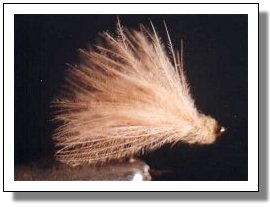
The CPF No-Hackle Caddis Dry Fly/Emerger (also called "Rump Caddis" in my book, Fly Patterns for the Adventurous Tyer, Volume 1) is an exceptionally easy fly to tie. It is effective as either a floating fly or, when fished just under the surface, as an emerger or "in-between" caddis. It can be tied in a variety of sizes and colors as necessary to imitate naturals.
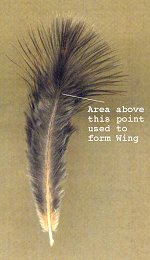 The
secret to the CPF Caddis's effectiveness lies in its use of
a feather often overlooked by tyers--a marabou-like feather
found just above the legs of a chicken or near the anus. I
jokingly refer to these as "Chicken Poop Feathers"
(or "CPF") because they are often flecked with tiny
spots of chicken poop.
The
secret to the CPF Caddis's effectiveness lies in its use of
a feather often overlooked by tyers--a marabou-like feather
found just above the legs of a chicken or near the anus. I
jokingly refer to these as "Chicken Poop Feathers"
(or "CPF") because they are often flecked with tiny
spots of chicken poop.
Chicken poop feathers, though closely related, should not be confused with what many call "chickabou"--a type of feather much too soft for our purpose. The proper feather for this pattern is relatively firm of stem and heavily barbuled along the individual barbs (see illustration). It's this concentration of barbules that traps air bubbles and allows the fly to float without dressing or--when pulled under--to gather about the barbules dozens of tiny air bubbles that mimic those of an emerging natural. DO NOT choose a feather that is wispy, limp and sparsely barbuled;the fly won't float nearly so well nor will it collect air bubbles as it should.
Tying the CPF No-Hackle Caddis Dry Fly/Emerger
Hook: |
Daiichi 1130, 1140, 1150, Mustad 94859, # 8-20 |
Thread: |
Danville's 6/0, color to match naturals |
Body: |
Slender thread body or a VERY slim body of dubbing of CPF fibers or antron in color to match natural. |
Wing: |
CPF feather (one on sizes 14-20,
two on sizes 8-12) |
Head: |
Dubbed CPF feather or antron dubbing |
About Corsair Tubing
As with all flies tied with Corsair tubing, it's very important to take particular notice of the thread lines (one on each side) that run along its length. The thread lines control the density, flexibility, and the degree to which the material can be stretched and tapered as well as shaped. In addition these thread lines may also serve to suggest the lateral lines of the natural baitfish (in this case the sand eel). It's important also to remember that thread lines must be secured or tied down at both ends to allow proper tapering and to maintain the desired shape.
Corsair tubing may be found in many fly shops or may be ordered directly from this site.
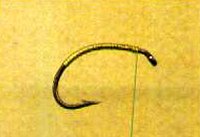 Wrap shank evenly with thread from eye
to around the bend of hook and back..
Wrap shank evenly with thread from eye
to around the bend of hook and back..
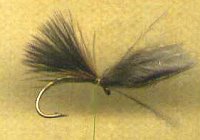 Tie in CPF feather(s) for wing. Wing should
extend back at least to bend of hook.
Tie in CPF feather(s) for wing. Wing should
extend back at least to bend of hook.
For best results, draw feather(s) through your thumb and forefinger so that you have a sort of compact "brush." Tie in the feather(s) with three or four firm but not tight turns of thread and then draw your feather(s) forward through the loops to further compact them before finally tying them down.
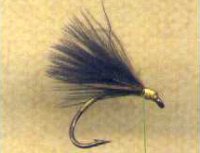 Trim excess CPF feather and tie down. Cover
any excess material with neat thread wraps.
Trim excess CPF feather and tie down. Cover
any excess material with neat thread wraps.
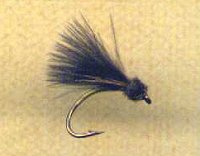 Dub some CPF fibers onto thread and wrap
on dubbing between base of wing and eye to form a "buggy"
furry head.
Dub some CPF fibers onto thread and wrap
on dubbing between base of wing and eye to form a "buggy"
furry head.






